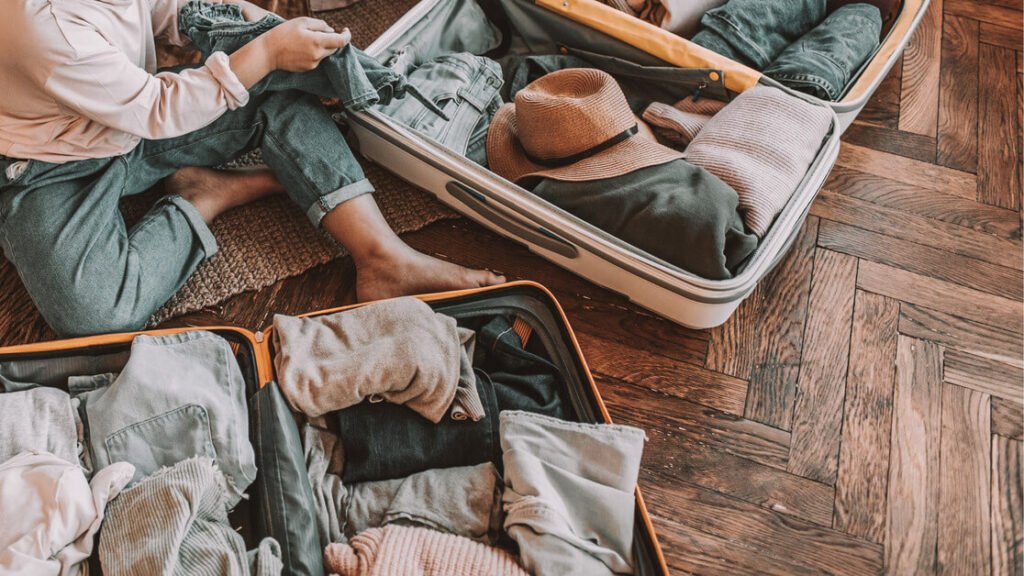Wondering how to pack a suitcase without wrinkles? It truly is more of an art than a science, and by using the right strategies, you can keep your clothes looking fresh and ready to wear—no ironing needed.
Few things are as frustrating as arriving at your destination, opening your suitcase, and finding your clothes with wrinkles and creases.
But the good news is, there are simple techniques to help you pack your clothes wrinkle-free.
Let’s dive into some of the best ways to pack your suitcase wrinkle-free!
How to Pack Without Wrinkles
1. Start with the Right Materials
Before you even start packing your carry-on luggage for your next trip, consider the types of fabrics you’re taking with you. Some materials are naturally more wrinkle-prone than others. If possible, pack clothes made from fabrics like:
- Polyester
- Nylon
- Knits
- Wool
- Cashmere
- Spandex/Lycra
These materials tend to resist wrinkles, making them ideal for travel.
If you’re unsure whether an item is prone to wrinkling, you can do a quick test: pinch a small section of the fabric, hold it for about 30 seconds, and then let go. If it’s wrinkled, it may need special packing techniques!
2. Rolling Clothes to Prevent Wrinkles
One of the best-known techniques for avoiding wrinkled clothes is rolling it. It may sound counterintuitive, but it actually works wonders for casual wear like t-shirts, jeans, and workout gear.

How to Roll T-Shirts:
- Lay your t-shirt flat on a smooth surface.
- Fold it in half vertically, aligning the sleeves.
- Fold the sleeves inward to form a long rectangle.
- Roll the shirt from the bottom up.
This method helps prevent wrinkles and saves space in your suitcase, giving you more room for other essentials.
Rolling Pants:
- Lay the pants flat.
- Fold them in half vertically, with one leg over the other.
- Start rolling from the waist down to the cuffs.
Rolling casual pants like jeans, leggings, and joggers is ideal. For more formal dress pants, you might want to use other techniques, as rolling can sometimes cause creasing in these delicate fabrics.
3. The Bundle Method
The bundle method works particularly well for packing delicate fabrics.
This technique involves wrapping your clothes around a central item (such as a toiletry travel bag or a packing cube), which helps distribute the pressure evenly, giving you wrinkle-free clothes.
How to Bundle Clothes:
- Start with the most wrinkle-resistant item, like a thick sweater or jacket, as your outer layer.
- Place a smaller solid item, such as your toiletry bag, in the middle.
- Wrap the sweater around the toiletry bag, folding the sleeves and body over.
- Add other clothing items like pants, shirts, and dresses, wrapping each around the central bundle.
- Keep the most wrinkle-prone items, like dress shirts and skirts, for the outermost layer.
The key here is to avoid any tight folds, which are the main cause of wrinkles. Your most delicate clothes should also be packed at the top of your suitcase.
4. Using Packing Cubes for Organization
Packing cubes are a fantastic investment if you want to keep your clothes organized and wrinkle-free. By using these small, zippered compartments, you can keep everything neatly in place without overcrowding your suitcase.
Packing cubes also reduces friction, which is one of the main causes of wrinkles. You can even use them to group your clothes by day, travel outfit, or type, making unpacking easier when your clothes arrive.
Another alternative is using plastic bags or dry cleaning bags to separate your things and help your clothes stay smooth.
5. The Folding Techniques
While rolling is great for casual clothes, folding works best for more structured or delicate garments like blazers, skirts, and button-up shirts.
However, there’s an art to folding clothes in a way that minimizes wrinkles.
Folding Shirts:
- Lay the garment flat and face down on a flat surface.
- Fold the sleeves backward, aligning them with the sides of the shirt.
- Fold the shirt horizontally in half, bringing the bottom to the top.
If done gently, this method reduces the number of folds and prevents deep creases from forming.
Folding Pants:
- Fold your pants in half, with one leg over the other.
- Lay them flat in your suitcase.
- Place bulkier items on top to prevent unnecessary creasing.
You can also use tissue paper between layers of delicate items like blouses or silk dresses. The tissue paper reduces friction, which can help with wrinkle-free clothing.
6. Packing Garment Bags
If you’re traveling with formal attire like suits or dresses, garment bags can be a lifesaver.
Simply hang your clothes inside the garment bag, fold it gently in half, and place it on top of your packed suitcase.
You can also add a layer of plastic, like dry-cleaning bags, to further avoid wrinkles.
Plastic helps clothes slide smoothly instead of rubbing against each other, reducing friction and keeping everything wrinkle-free.
7. Avoid Overpacking
Overpacking your suitcase is one of the easiest ways to create wrinkles.

When clothes are crammed into a small space, they’re bound to come out wrinkled.
How to Avoid Overpacking:
- Pack light and only what you need. Check the weather at your destination and plan outfits accordingly.
- Try to mix and match items to create multiple outfits with fewer pieces.
- If possible, leave a little extra space in your suitcase. This allows your clothes to breathe and prevents them from getting squished.
8. Utilize Wrinkle Sprays and Steamers
Even with the best packing techniques, wrinkles can sometimes still happen.
That’s where wrinkle-release sprays and portable steamers come in handy.
Wrinkle-Release Spray:
These sprays work by relaxing the fabric fibers, allowing you to smooth out wrinkles with your hands. They’re quick, easy, and don’t require an iron.
Portable Steamer:
If you’re traveling with delicate fabrics or need to look polished for an event, a portable travel steamer is a great investment.
These small, travel-friendly devices work wonders for smoothing out wrinkles in just a few minutes.
9. Hang Clothes Upon Arrival
One of the simplest ways to prevent wrinkles after unpacking is to hang up your clothes immediately upon arrival.
This allows any minor creases to fall out naturally.
If you’re staying somewhere with limited hanging space, try draping your clothes over chairs or even the edge of the bathtub.
10. The Shower Steam Trick
If you don’t have access to a steamer or iron, the steam from a hot shower can work in a pinch.
Simply hang your clothes in the bathroom while you take a steamy shower. The steam will help relax the fabric and ease out some wrinkles.
Wrapping Up
Learning how to pack a suitcase without wrinkles is a skill that can save you time, hassle, and frustration during your travels.
Whether you roll clothes, bundle your delicate items, or invest in packing cubes, these techniques are easy to master and will help keep your wardrobe looking fresh.
Remember, the key is to prevent friction, avoid overpacking, and give your clothes a little breathing room to avoid wrinkled clothing.
So, next time you pack for a trip, use these tips to keep your outfits wrinkle-free, and you’ll be ready to go as soon as you land!
I hope you liked this guide and helpful tips on wrinkle-free packing. Be sure to also read:
- How to Pack in a Carry-On Like a Superstar!
- Best Travel Bags for Women | My Favourites You’ll Love
- Best Anti-Theft Bags, Crossbodies & Purses for Travel
- Best Backpack Purses For Travel You’ll Love (Reviewed)
- Best Crossbody Bags for Travel: Any Trip & Budget
As usual, feel free to comment with any questions or ideas below.
All the very best,
//Josephine
